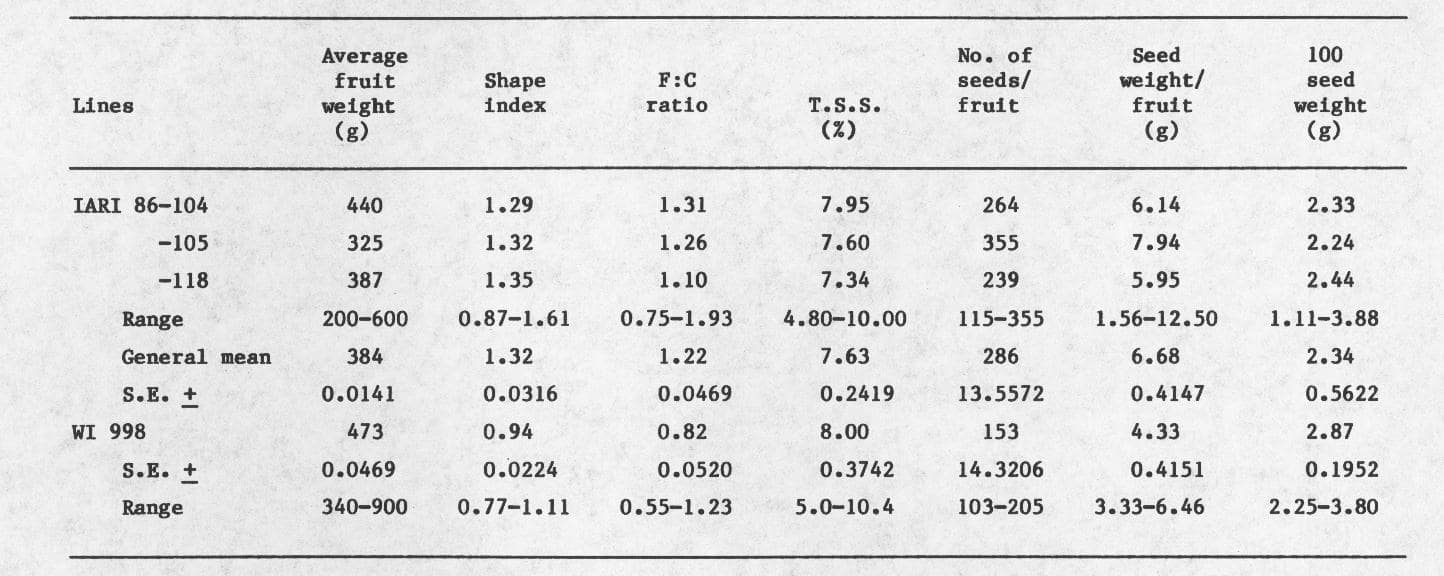Cucurbit Genetics Cooperative Report 10:49-50 (article 28) 1987
T. A. More, V. S. Seshadri and M. B. Magdum
Division of Vegetable Crops, Indian Agricultural Research Institute, New Delhi-110012, India
Development of true breeding gynoecious lines has led to phenomenal exploitation of heterosis and development of hybrids in cucumber. Research on this aspect in muskmelon has been in progress and Peterson et al. (1983) developed a stable gynoecious line, Wisconsin 998 (WI 998).
At the Indian Agricultural Research Institute, New Delhi, three gynoecious lines namely 86-104, 86-105, and 86-118 have been bred for true breeding gynoecious sex. The first two lines came from a cross between a gynomonoecious line and hermaphrodite-2 (Ac. No. 433), two of the parents were introduced from Bulgaria and the third one came from a cross between Monoecious-1 (developed at this Institute) and hermaphrodite-1 (EC 70674 i.e. AC No. 354). Original crosses were made by Magdum in 1979-80 and reported in 1982. All the gynoeocious lines in this report are in F6 generation. From F2 onwards, efforts were made to select only the pure gynoecious plant from the segregating population and plants were maintained by layering followed by 400 ppm silver-nitrate spray. Perfect flowers were induced after three months of scoring for gynoecism and were increased either by selfing or sibbing. For advancing the generations from F4 onwards, the plants were scored for gynoecious stability for 8-10 weeks at which stage they were sprayed with 400 ppm silver-thiosulphate (STS). This treatment induced perfect flowers and seeds were produced. Thus, the parents were maintained in pure gynoecious state. By this way the scoring for gynoecious stability and maintenance was achieved in the same growing season. In later generations the selected lines were sprayed with 400 ppm STS at two true leaf stage and the perfect flowers were induced, which were used for perpetuation of gynoecious stock. In this method, it was assumed that a genetically true breeding gynoecious plant, after temporary induction of perfect phase, should revert back to gynoecious phase again, once the effect of exogenously applied STS has been lost.
F:C ratio and number of seeds per fruit were higher in I.A.R.I. gynoecious lines compared with WI 998 (Table 1). All the four gynoecious lines have to be improved for T.S.S. content, keeping in mind the consumers’ preference for sweet fruits in India. For the remaining characters, WI 998 was comparatively better than the gynoecious lines under report.
Summing up the results, it is reported that these gynoecious lines need further improvement for horticultural characters especially fruit weight, shape index (preferably round) and T.S.S. content. These characters can be improved to the desired level by further selections. It is worthy of mention here that these lines were always scored for gynoecism from the end of March to the middle of June when the temperatures were 40°/25°C (day/night) and above with the prevailing long photoperiod, under field conditions. This report brings out the possibility of developing a stable gynoecious line in muskmelon under high temperature and long photoperiodic conditions compared to the earlier report of Peterson et al. (1983) who developed a stable gynoecious line under comparatively moderate environmental glasshouse conditions.
Table 1. Mean performance of different gynoecious lines.

Average fruit weight and number of seeds/fruit were equated to the nearest whole number.
Literature Cited
- Magdum, M. B. 1982. Studies on sex forms in muskmelon (Cucumis melo L.). A Ph.D. thesis submitted to Post-Graduate School, Indian Agricultural Research Institute, New Delhi, India. (Unpublished)
- Peterson, C. E., K. W. Owens, and P. R. Rowe. 1983. Wisconsin 998 muskmelon germplasm. HortScience 18(1):116.